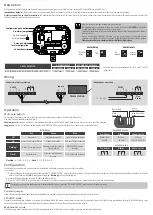
Instructions
GB
5762H402 Ed.01
AKO-57624
3
5
5
7
6
2
4
0
2 R
EV
.0
0 2
0
1
9
AKO ELECTROMECÁNICA
, S.A.L.
Avda.
Roquetes, 30-38
08812
•
Sant Pere de Ribes.
Barcelona
•
Spain.
Tel.: +34 902 333 145
Fax: +34 938 934 054
www.ako.com
We
reserve the
right to
supply materials
that might
vary
slightly to
those
described in
our Technical
Sheets.
Updated information
is av
ailable on
our
website.
Installation
2
1
Option A
Fixed by screws
36 mm
70 mm
3
1
2
Optional rear
cable entry
3
.3
3
.1
3
.2
Option B
Fixed by an
adhesive
General warnings
-Using the unit without observing the manufacturer's instructions may alter the appliance's safety requirements.
- Detectors should be installed in a place protected from vibrations, water and corrosive gases, where the ambient
temperature does not exceed the value indicated in the technical data.
- Detectors supervise a point and not an area. If the gas leak does not reach the sensor, or the level of
concentration in that point does not reach the alarm values, no alarm will be activated. If perimeter
supervision is required, several sensors should be installed around that area.
Working conditions:
-Keep the detector work environment free of chemical agents (such as solvent, paints, alcohol, acetone, silicone, etc.), and
free of engine fumes or gases from fermentations (bread, pizza) or ripening (breathing) of fruits.
-The detector should generally be installed in an area of potential concentration/accumulation of gas, in low positions (due
to the greater relative density, in relation to air, of the gases subject to detection).
Connect
following the
diagrams
x2
Ø 2,8 mm
x2
+
Ø 5 mm
Carefully perforate the rear entry so as not
to damage the electronic board.
This option involves changing from
IP68 to IP40.
Warning
The
AKO-57624
refrigerant gas detector may only be used in locations that have not been classified with risk of
explosion.
The detector is set at a value lower than 25% of the LEL (Lower explosion limit) of the refrigerant (see table). In the
event that the concentration of the refrigerant leak reaches the setting value, the detector activates an alarm and must
activate a forced ventilation system (*).
(*) The forced ventilation system must be suitably proportioned to ensure that the concentration of refrigerant in the event
of a leak is below the LEL.
Reference regulations: EN 378
Applicable local regulations: Compliance must be ensured
Refrigerant
LEL (%)
Detector settings (%)
R-1234yf
6.2
< 1.5
R-454C
7.9
< 2
R-454A
8.5
< 2.1
R-455A
11.9
< 2.9
R-32
14.5
< 3.6
Technical specifications
Power supply.........................................................................................................12-30 Vdc
Consumption Typical ..............................................................................................75 mA
Maximum .......................................................................................150 mA
Alarm relay ...................................................................................SPDT 30 Vdc, 2A, cos
j
=1
Working ambient temperature .............................................................................-20 to 50 ºC
Storage ambient temperature ..............................................................................-20 to 60 ºC
Range of moisture permitted ............................................0 - 95 % RH (Without condensation)
Protection degree ..........................................................................................................IP68
Dimensions ...................................................................107 mm (W) x 85 mm (H) x 39 mm (D)
Complies with the EN 14624 standard.



















